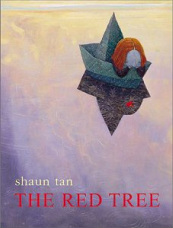 The red tree by Shaun TanSimply Read Books, 2003I unabashedly adore Shaun Tan. It should be noted that this was not the case before I read The red tree. Granted, I think his The arrival is a work of genius, but The red tree spoke to me so vividly that I would probably be struck dumb if ever I was lucky enough to meet him. The premise of The red tree is simple: a young girl wakes up and "...the day begins / with nothing to look forward to / and things go from bad to worse,"* until the end of the day when something remarkable happens. The execution, however, is anything but simple: the illustrations are stunning and the text is spare and poetic. The phrases Tan uses get right to the point, from "nobody understands" to "sometimes you just don't know what you are supposed to do." Hopelessness, fear, and yearning permeate this day in the small girl's life. The illustrations start out simply, with a depiction of the girl getting out of bed taking up about a fifth of the story's initial two-page spread. They do not stay simple however, and scenes straight out of a dark fantasy emerge. From desolate landscapes to massive mechanical dragons and ships in roiling seas, the small protagonist encounters a long sequence of unwelcoming environments. A lone red leaf is with her throughout her day, something that I did not catch until I read the book a second time. Having read two of Shaun Tan's other books - The arrival (2007)and Tales from outer suburbia (2008) - it is fascinating to see how some visual elements from The red tree are also found in those books. For example, one of the earliest scenes in The red tree shows the girl with a large old-fashioned submarine helmet on her head, which is very similar to the helmet found on the cover of an edition of Tales from outer suburbia. While the human characters in The arrival are more realistic in their features, the alien space and objects in The red tree have similarities to the atmosphere in The arrival. This is a book that is, arguably, for older students. While it is as dark as it is beautiful, I would not shy away from having it in an elementary library. However, I believe that older students, especially teens, would get a lot more out of The red tree. As an adolescent I remember often feeling hopeless, misunderstood, and like nothing good would ever happen to me, and anecdotal evidence suggests that many others would agree. The red tree is a beautiful, poignant book that I will purchase for the school libraries I manage, and a thousand thanks to my professor for the recommendation. *Another unpaginated picture book! These lines are the first three lines of the book, but all other quotes in this review will not be given a page reference.
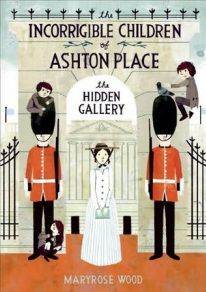 The Hidden Gallery (The Incorrigible children of Ashton Place, book 2) by Maryrose Wood
Balzer + Bray, 2011
Governess Penelope Lumley is off to London with her three pupils - Alexander, Beowulf, and Cassiopeia Incorrigible - and their guardians, Lord and Lady Ashton. Penelope is excited to be able to visit with her beloved former headmistress, Miss Mortimer, and begins planning educational walking tours around the city for herself and the children using the guide Miss Mortimer sent to her. Things begin to go awry as soon as she and the Incorrigibles step off the train, from getting lost to strange proclamations from a fortune teller, but Penelope continues to be optimistic. When a luncheon with Miss Mortimer takes a mysterious turn, Penelope becomes determined to get to the bottom of who may be threatening her beloved Incorrigibles and why they were left in the woods to be raised by wolves in the first place.
The Incorrigible Children of Ashton Place books are spoofs of classic governess novels (such as Jane Eyre) and poke a lot of fun at Victorian life and culture, and this second book in the series certainly delivers on those counts. The fact that the children were actually raised by wolves is a gimmick that is still paying off in The hidden gallery, although I find that the children have stagnated a bit in their development and acculturation. In the first book (which I read a few months ago so have not reviewed here), the children had just been discovered so could not speak human language and were terrified of their new situation. The process of their linguistic and cultural acquisition was handled in a manner that was both charming and hilarious, as were Penelope's reactions to and methods of teaching the children. In this second book, while still charming and often hilarious, the children did not develop very much further. True, they are all clever and learn quickly, whether it's navigation techniques or geometry, but their skills did not seem to improve very significantly. Perhaps it is inevitable that they would not develop as much as during the first book, but more individual character evolution would have been nice to see, as in my mind the three children are almost interchangeable.
This lack of character development does not apply to Penelope, who is earnest and also very clever, if a bit naive. She doesn't shy away from a challenge (if it wasn't already obvious when considering her pupils), even if that challenge is befriending the moody, spoiled Lady Ashton. Indeed, Penelope has the sort of astute intellect that would be a menace if she discovered the powers of sarcasm. The addition of Simon Harley-Dickinson - whose surname I nearly always misread as Harley-Davidson - to the cast of characters was welcome, and I also enjoyed learning more about housekeeper Mrs. Clarke.
There is an entangled mystery to the Incorrigible Children books, and that is why the children were raised by wolves in the first place and what connection Lord Ashton has to them. Penelope is also tied up in all of this as an orphan who has the same hair colour as the Incorrigibles. Now, by the end of the first book it was obvious what was going on with Lord Ashton (I won't ruin it for you though), and by the end of The hidden gallery Penelope seems to have it figured out although it is not spelled out to the reader. True, perhaps Maryrose Wood assumes all the readers know what is going on with Lord Ashton, but it seems drawn out longer than necessary. I worry that, as much as I delight in these books, the mysteries will be drawn out to the point that the books will become episodic. I sincerely hope that does not come to pass.
As soon as I found out that there was a second book about Penelope and the Incorrigibles, I was determined to get my hands on it, and overall this sequel does not disappoint with its pokes at Victorian culture that made me giggle out loud. I am now waiting to get my paws on the third.
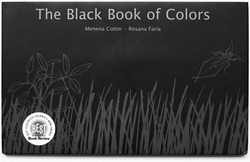 The black book of colors by Menena Cottin and Rosana Faria, translated by Elisa Amado
Groundwood Books/House of Anansi Press, 2006
More than any other book I've come across - certainly more than any other picture book I've encountered - The black book of colors gives those of us with the ability to see an idea of how we might perceive colours if we were blind. Printed entirely on black paper, a boy named Thomas describes what colours mean to him, beginning with, "Thomas says that yellow tastes like mustard, but is as soft as a baby chick's feathers."* A Braille translation is provided above the printed white text, and the page opposite the text and the Braille is comprised of an embossed representation of how Thomas interprets the color, in this case delicate feathers. The reader is able to read the text, feel how the same words are written in Braille, and feel the raised images.
Image from: http://erin-thefoolscapflyer.blogspot.com/2009/08/black-book-of-colors.html This isn't just a gimmick either, as the text is spare and evocative. Some connections seem more likely than others, such as brown smelling like chocolate, and other colours are very personal to Thomas, as with black feeling like his mother's hair falling on his face when she hugs him. The black book of colors takes colours into the realm of having meaning and associated emotion, well past mere visual processing of the electromagnetic spectrum.
*Book is not paginated.
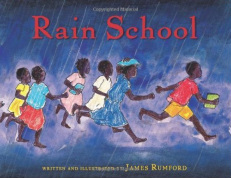 Rain school by James Rumford
Houghton Mifflin Harcourt, 2010
It is the first day of school for Thomas and the other children of his village in Chad. When Thomas and the other children arrive there is no school building, just a teacher. The students' first lesson is how to build a school from the ground up, as they do every year after the summer rainy season.
Rain school stems directly from James Rumford's experience as a Peace Corps volunteer in Chad and his knowledge shows. Many details, from the patterns of fabric to the local fauna, make it evident that he is familiar with the country. The backgrounds of the illustrations are predominantly shades of yellow and orange, which not only gave me a sense of heat but also provide an appropriately joyous atmosphere to the book.
It is difficult for many of us to imagine having to build a school every September in order to have a place to learn or teach. However, people in many parts of the world are not as lucky as we are and need to go above and beyond simply to learn, and Rain school is a delightful introduction to the topic.
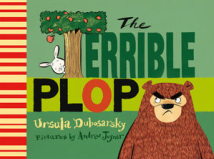 The Terrible Plop by Ursula Dubosarsky with pictures by Andrew Joyner
Penguin Books for Children, 2009
The Terrible Plop is a book that starts
With a PLOP that trembles the rabbits' hearts.
They start to run and when they do
The forest critters follow, too.
While all the creatures run away
The big brown bear decides to stay.
What will happen when the bear goes to see
The PLOP that's causing everyone to flee?
In rollicking text that has a pleasing rhyme,
This book is joy at read-aloud time.
A touch of mystery, colourful art,
and humour set Terrible Plop apart.
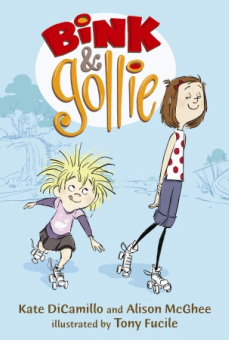 Bink & Gollie by Kate DiCamillo and Alison McGhee, illustrated by Tony FucileCandlewick, 2010 Bink, a small girl with wild blonde hair, lives in a homey little cottage while Gollie, a tall brunette, lives in a tidy modern home in a tree (yes, a treehouse!). Through the course of three short chapters, the girls have small adventures which demonstrate the ups and downs of friendship. Bink & Gollie is absolutely delightful. The girls, apparent best friends and near-constant companions, seem to have little in common. Gollie has an outwardly calm demeanor and uses a charmingly old-fashioned vocabulary - '"Greetings, Bink," said Gollie. "I long for speed"' (p. 3). Bink, on the other hand, has a disheveled look about her and her actions are propelled by emotion and other drives, such as hunger. Together, they work to find compromises when they have disagreements and do their best to see one another's perspective. The illustrations are as charming as the characters themselves. Tony Fucile uses colour to accentuate components in his predominantly grey-scale drawings, from signs in store windows to a new goldfish. Bink and Gollie themselves are always in full colour, and one touch I especially enjoyed was the smudge of orange to indicate Fred in the frozen pond on the final page. Although there are many details within the illustrations (like Gollie's treehouse, which I now covet), care was taken not to detract from the two girls. A wonderful collaboration (which makes me wonder if DiCamillo is more like Bink and McGhee is more like Gollie, or vice versa*) with an endearing result. *Read this article to find out!
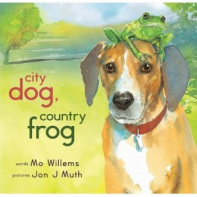 City dog, country frog by Mo Willems, illustrated by Jon J. Muth
Hyperion, 2010
When City Dog arrives for a visit to the country in springtime, he heads off for a gleeful leash-free run and encounters Country Frog. When asked why he is sitting on a rock, Country Frog replies that he is waiting for a friend, but that City Dog will do. Thus begins a friendship that lasts through the seasons.
Picture books of friendship don't come much more poignant than this. Mo Willems is a master of subtly injecting emotion into the play of words and images in his books, and combining his words with Jon J. Muth's expressive watercolour illustrations is a match made in heaven. The colours capture the essence of the four seasons and the animals have obvious personalities. City Dog's tail and ears are consistently perfect, and in the image below his confusion at Country Frog's absence is evident. The illustrations extend Willems' carefully selected words and, in keeping with the origins of the word, beautifully illuminate them.
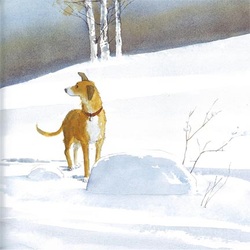 Image from: http://32pages.ca/2011/01/07/a-dog-a-frog-and-an-apology/ I'm not going to lie: I've read this book three times and I've been misty-eyed on every occasion. You see, Country Frog doesn't survive past autumn and City Dog persists in waiting for him to reappear into the following spring. (Lest you think the book ends on a sad note, rest assured that City Dog befriends another country creature.) Bittersweet and beautiful it most certainly is, and well worth a look.
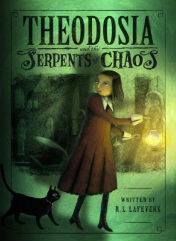 Theodosia and the Serpents of Chaos by R. L. LaFeversHoughton Mifflin, 2007 Theodosia's parents both study ancient Egypt and work for London's Museum of Legends and Antiquities. As a result, eleven-year-old Theodosia spends almost all her time at the museum which is wonderful since she is interested in antiquities, but it's not so great because she can sense the ancient curses that surround many of the Egyptian artifacts. When her mother finds and brings the legendary jeweled Heart of Egypt to the museum, Theodosia is not the only person who knows of its devastating powers, but it appears that she may the only one who can save Britain from the doom to come. What a rip-roaring adventure! It's almost like The Mummy but with children as protagonists (and I mean that in the best possible way: action, adventure, Egyptian curses, chase scenes, but unfortunately for me no Medjai, sigh). Serpents of chaos also involves pickpockets, a stowaway, hidden burial chambers, a demonized cat, and a secret brotherhood. How's that for excitement! Amidst it all, Theodosia as a character is solid as a rock. She is clever, independent, daring, and is rather attached to her cat's presence while she sleeps in an empty sarcophagus most nights (her father is the Head Curator and rarely leaves his place of work while his wife is away on a dig). She also realizes that her ability to sense curses makes her different from her parents, and as a result she is essentially an expert in neutralizing Egyptian curses due to her extensive studies while she is stuck at the museum. The adults who surround her on a daily basis fail to recognize her knowledge, which causes Theodosia much frustration. This frustration drives many of her actions throughout the book, and she is determined to prove to her parents that she is of great worth. The historical setting is an interesting one. The events occur in what seems to be early 1914, and the author does a stand-up job of simply explaining the complicated international relations that existed at that time and which provide a backdrop to the significance of the Heart of Egypt. I'm curious to read the sequels to Theodosia and the Serpents of Chaos for many reasons, but one of the main ones is to find out how the advent of the First World War will be incorporated into the plot if, indeed, it is. This is a novel that should appeal to boys and girls with its wit, adventure, and magic, and will likely spur interest in ancient Egypt as well.
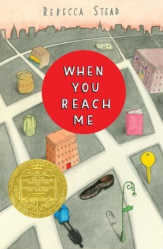 When you reach me by Rebecca Stead
Wendy Lamb Books (Random House), 2009
It's 1978 and Miranda is in sixth grade in New York City. She and her best friend Sal are drifting apart, and mysterious letters keep appearing which are addressed to her and accurately predict the future. Miranda doesn't know what to make of the notes and the events they describe, but her absolute favourite book - A wrinkle in time by Madeleine L'Engle - may turn out to be the key to the mystery.
There is so much going on in this brief (197-page) novel that it would take another few paragraphs to write a synopsis that covers the key plot points. I do not say this disparagingly in the least, as the author handled the story's complexities extraordinarily deftly and, for the most part, linearly. It is quite a feat, as is the fact that I hadn't the slightest clue who the mysterious letter-writer was until it was revealed. In fact, it is a book I intend to re-read in order to discover what I missed the first time.
The characters are what made this book a joy for me to read. Miranda is intelligent, perceptive, and valiantly trying to make some sense of the world around her. I appreciated the little details about her inner life, such as how she balances her fears with her realism by approaching people she's afraid of to ask the time so she can see that they are, in fact, not so scary. Also, she is aware of the little moments of poetry in daily life while not noticing that a close friend eats a special diet, which is that odd mix of worldliness and obliviousness that can be found in many 11-year-olds.
When you reach me is, at its essence, about the interactions between people in Miranda's world: Miranda's relationships with her mother and her mother's boyfriend, sixth-grade friendships that form almost as mysteriously as they end, and Miranda's observations of the people within her neighbourhood. The characters are lively and real and had their own things going on outside the walls of the story, especially Marcus and Julia. There always seemed to be a lot going on for Miranda, even if big events didn't happen very often. And if that isn't an accurate depiction of real life, then I'm not sure what is.
When you reach me is the Newbery-winning novel of 2010 and rightly so.
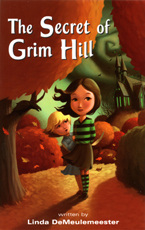 The Secret of Grim Hill by Linda DeMeulemeester
Lobster Press, 2007
Cat and her younger sister, Sookie, have just moved to a new town with their mother, and Cat is not enjoying Darkmont High at all. Soccer-playing Cat soon finds out about soccer scholarships to the nearby private Grimoire school that are earned by the winning team of a Halloween match. Despite continually hearing from Sookie and their neighbour, Jasper, that something just isn't right about Grimoire, Cat goes ahead with her daily team practices until the bizarre events of an early Halloween party change her priorities.
I was spurred to read The Secret of Grim Hill by a new student who wondered if the library had the sequels because he enjoyed this book so much. He reads a lot and very quickly, so I thought if he liked it then it must be pretty good. Happily, it is.
Cat is a realistic tween protagonist: she is easily annoyed by her younger sister, very aware of her school's social hierarchy and endeavours to climb it, fulfills her household responsibilities despite wishing she didn't have to, and is quintessentially likable. When push comes to shove, Cat's priorities are in order (soccer and family at the top with homework dead last). Sookie is as much or even more compelling as a precocious, Monopoly-loving little girl who is generally as seemingly as annoyed with Cat as Cat is with her.
The atmosphere of Grim Hill is generally light with escalating indications to the reader that something dark is afoot. DeMeulemeester's incorporation and explanations of Celtic mythology and traditions are seamlessly done, and the tension builds to a peak that is exhilarating and urgent but not full-on scary. I look forward to reading one or more of the sequels (loaned from another school library for the student mentioned earlier) to see if the Celtic theme is maintained or if other mythologies are incorporated into the series.
Overall, a solid beginning to a middle-grade fantasy series.
|



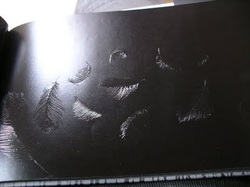








 RSS Feed
RSS Feed